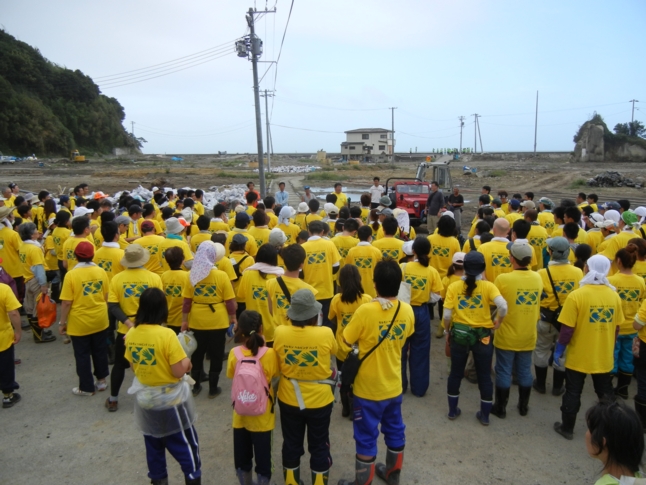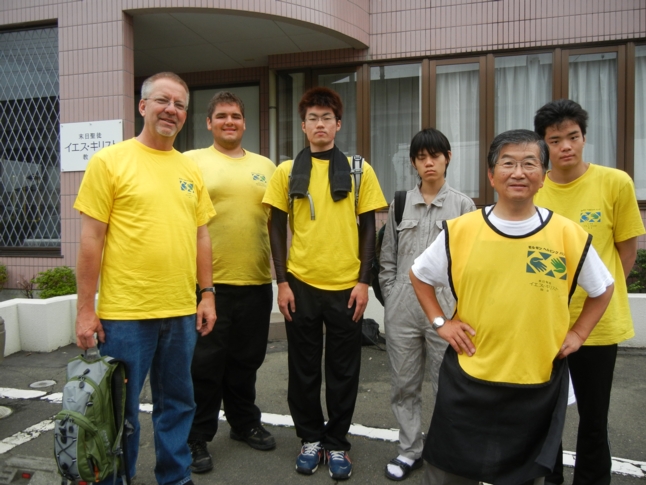Japan Sendai Mission 日本仙台伝道部
Teruya Jidai ('74-'77) 照屋時代帰還宣教師
RM Site-同窓生サイト
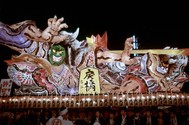
2011 Disaster 大震災
In Japan, the 2011 earthquake and tsunami disaster is known as 東日本大震災 (Higashi Nihon Dai Shin Sai). The purpose of these pages is to report and discuss from a historical perpective Daishinsai events and their effect on the mission, missionaries and church members. For general information and data, here's Wikipedia's Daishinsai Article.
This section was compiled from the contemporaneous RM Site postings I made in the weeks and months following the Daishinsai. Information sources at the time were primarily news reports, postings and emails from mission president Reid Tateoka, his successor, Gary Rasmussen, and from missionary parents and RMs. My own observations from three trips back during this period (April & September 2011, June 2012) are also included. Comments and feedback are welcome via a 'Contact Us' entry.
|
Daishinsai Index: click to jump directly to topics below, or just scroll down
|
|
The disastrous ~9.0 magnitude earthquake struck at 2:46 PM local time Friday 11 Mar 2011, with an epicenter undersea about 80 miles east of the city of Sendai. It was followed by a tsunami of up to 10 meters (33 ft.) that caused complete devastation in primarily remote, smaller coastal fishing towns such as Kessenuma, Minami Sanriku and Rikuzen Takata. (We understand Church members living in or near these seaside towns attended church primarily in Ichinoseki.) Tagajo, Ishinomaki and Miyako, three larger seaside cities where church meetinghouses are located, were also hard hit by the tsunami. With hindsight, we now know almost 18,500 people died as a result of the epic disaster. For about three months the Church reported none of its members were known to have perished, but eventually it was confirmed that two did.
Accounting for all Missionaries and Members
Mission President Reid Tateoka was in Kōriyama for zone meetings with missionaries at the time of the quake and was unable to return to Sendai due to the disastrous road conditions. Communication was next to impossible in the Sendai area, but working under an established emergency contact plan, each pair of missionaries reported in, primarily using their cell phones. (cellular phone service was available in many areas for a time due back-up power) About 36 hours after the quake, the Church officially announced all missionaries were safe and accounted for. Knowing that a handful of missionaries could have very easily been in the low-lying tsunami areas where missionaries actually live and work, it is miraculous that all missionaries were in safe places when disaster struck. Here are personal stories of the disaster of ten Sendai missionaries, together with two others from the disaster area.
Pres. Tateoka coordinated with the Asia North Area Office in Tōkyō which was in touch with Church headquarters in Salt Lake City. He also worked with local church leaders in their efforts to account for their members. The Church used its Japanese website to give instructions for helping to confirm the status of members in the stricken areas, help disseminate volunteer information, and coordinate relief efforts.

Meanwhile, radiation leaks from a troubled nuclear power plant (discussed in more detail below) raised global concerns.
About four days after the disaster, on 15 Mar 2011 (MT) (16 Mar JT), the Church announced it would move the missionaries out of both the Sendai Mission (~72 missionaries) and Tōkyō Mission (~118 missionaries) to other missions in Japan, in an effort to move them to safer areas (and to minimize people/parents worrying about them). In order to make room for missionaries being evacuated, a total of 45 missionaries with less than three months remaining on their missions in (all missions in) Japan were sent home early and immediately. We learned the next day that all Sendai Missionaries were to be moved to the Sapporo Mission and Tōkyō Missionaries were to be split among the Nagoya, Kobe and Fukuoka Missions.
Locating all the Sendai Missionaries and informing them of the move was a huge task, given the region's damaged infrastructure, fuel shortages, spotty power and cell service. Two sister missionaries serving in Ishinomaki were the last to be removed to a safe zone for the transfer. (They immediately reported themselves as safe after the quake, but then couldn't be located for four days-they were out helping others and their cell phone batteries had died.) Sendai Missionaries were transferred in a difficult logistical operation. Most were bussed to Aomori then flew to Tōkyō (Haneda Airport), others rode in cars/trains to Tōkyō. By 18 Mar 2011, all Sendai missionaries had arrived in Sapporo by air. Many inspirational details about these events as they occured are described more fully in President Tateoka's Personal Account of the Disaster. Reid Tateoka also wrote his account as an Ensign article for young adults that was published in 2018.
We can't imagine how difficult it was for Sendai Missionaries to leave their areas of labor, most without being able to notify investigators and members whom they had grown to love, and without knowing when or if they would ever return to Tōhoku.
For President and Sister Tateoka, these events were surely even more difficult and heart-wrenching. Since President Tateoka held the Priesthood keys for all the (non-Stake) Church units in Tōhoku, he stayed on there to carry on that responsibility. President and Sister Tateoka were allowed to accompany the last missionaries to be evacuated to Sapporo. There they were able to have one, and in everyone's minds, perhaps final, emotional taikai (conference/meeting) with their missionaries before returning to Tōhoku to devote their full attention to the extensive needs of the members there. Afterward, all Sapporo missionaries were also brought into the city of Sapporo for a huge transfer/reassignment. Sendai Missionaries were now Sapporo missionaries, and from blog postings of Sapporo Mission President Daniels, we understand "the two missions [were] completely integrated, with a Zone Leader from each mission leading the zones and actually more District Leaders from the Sendai Mission than the Sapporo Mission leading the individual Districts. We are excited to see the surge in the work as we prepare for the temple that has been announced for Sapporo."
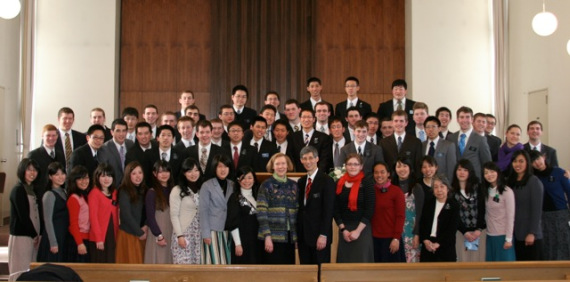 |

Fukushima Dai-ichi Nuclear Plant
.jpg) The crippled Fukushima Dai-ichi nuclear power plant shut down automatically at the time of the earthquake but its critical spent nuclear rod cooling/containment and backup systems were wiped out by the tsunami. The plant was built in the 1970s by General Electric under contract from Tōkyō Electric Power Company (TEPCO). The plant supplied power to Tōkyō, more than 175 miles distant, and not to the surrounding area. Trains in Tōkyō were suspended at the time of quake, stranding tens of thousands of commuters, but most trains resumed to limited service the next day.
The crippled Fukushima Dai-ichi nuclear power plant shut down automatically at the time of the earthquake but its critical spent nuclear rod cooling/containment and backup systems were wiped out by the tsunami. The plant was built in the 1970s by General Electric under contract from Tōkyō Electric Power Company (TEPCO). The plant supplied power to Tōkyō, more than 175 miles distant, and not to the surrounding area. Trains in Tōkyō were suspended at the time of quake, stranding tens of thousands of commuters, but most trains resumed to limited service the next day.
Fukushima Dai-ichi is located on the mostly rural Pacific coast fairly close to three mission cities: Iwaki (26 miles), Kōriyama (37 miles) and Fukushima (40 miles), with mountain ranges in between. Radiation news grew worse over time after the disaster. About ten days out, the mandatory evacuation zone of 20km (13.2mi) was extended to 30km (19.8mi). Alarming radiation levels were reported in seawater near the plant. One month out, the Japanese government nuclear safety agency raised its crisis level from 5 to 7; level 7 is highest rank on international standard and equivalent to the severity of 1986 Chernobyl disaster; the agency said volume of radiation from Fukushima is one-tenth that at Chernobyl. As more international assistance became more evident, the news became worse.
Disaster Cleanup and Humanitarian Relief moved forward, but with many transportation links damaged, food and fuel were limited in some areas for a time. Many worldwide news reports focused on the strength, character and resilience of the Japanese people. Impassible roads and heavily damaged train lines were repaired and reopened in a surprisingly short period of time, one after another.
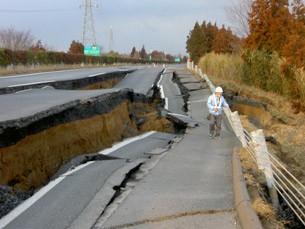 |
|
| Only in Japan: this earthquake-damaged road in Ibaraki Prefecture was repaired in only 6 days! | |
| photo credits: AP, NEXCO East | |
US TV network reports pointed out that looting didn't happen as it would have in most countries. These reports, together with the perception that Japan was a rich country with financial resources, might have had a negative effect on the amount of worldwide public financial relief received. The Church suggested donations to its Humanitarian fund. Japan's government specifically asked for official assistance from the US, UK, Canada, South Korea, Australia and New Zealand. Many more countries sent teams and resources to aid in the humanitarian effort.
 Transportation Since trains, especially Shinkansen, are a symbol of national pride, the repair and resumption of train service was of utmost importance for the Japanese national psyche. Large stickers were affixed to Shinkansen with slogans such as, "Ganbarō Nihon, Ganbarō Tōhoku," "Tsunageyō Nippon," urging the pending re-linking. Finally, Shinkansen (bullet trains) became operational on all routes in Tōhoku on 29 Apr 2011, only 50 days after the disaster, though at reduced speeds between Sendai and Ichinoseki.
Transportation Since trains, especially Shinkansen, are a symbol of national pride, the repair and resumption of train service was of utmost importance for the Japanese national psyche. Large stickers were affixed to Shinkansen with slogans such as, "Ganbarō Nihon, Ganbarō Tōhoku," "Tsunageyō Nippon," urging the pending re-linking. Finally, Shinkansen (bullet trains) became operational on all routes in Tōhoku on 29 Apr 2011, only 50 days after the disaster, though at reduced speeds between Sendai and Ichinoseki.
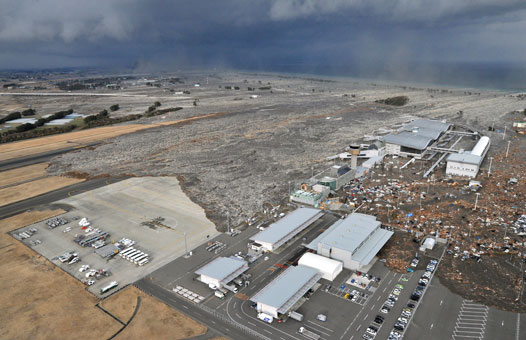 |
| Sendai Airport, with tsunami damage - reopened 13 Apr 2011, only one month after the disaster |

The Senseki local line from Sendai to Ishinomaki went only as far as the Tagajo/Shiogama area until 2015, when the line was restored all the way to Ishinomaki.
Trains on the Jōban line that skirts the Pacific coast from Tōkyō through Iwaki to Sendai operated only as far north as Iwaki, due to the radioactivity around the Dai-ichi Plant, located just 25 miles north of Iwaki. Symbolically, on 14 Mar 2020, exactly nine years after the disaster, the Iwaki to Sendai leg of the Jōban line was finally reopened, allowing both local trains and Hitachi tokkyū (limited express trains) to once again run all the way from Tōkyō to Sendai.
Conditions soon improved in Tōhoku - on 02 May 2011 Niigata Zone and Aomori Zone missionaries were allowed to return to the mission, and on 24 May, after just over two months of serving in Hokkaido, all other Sendai Missionaries returned. However, due to radiation level concerns, no missionaries were initially allowed to return to any mission areas in Fukushima-ken. President/Sister Reid/ShaunaTateoka's three year service ended 30 Jun 2011, and President/Sister Gary/Pam Rasmussen began their service the next day, 01 Jul 2011.
One month later, in August 2011, five months after the disaster, two missionaries were allowed to return to the city of Aizuwakamatsu in Fukushima-ken, but not to the other three branch areas in that prefecture: Iwaki, Fukushima and Kōriyama. Members were resilient and determined to 'ganbaru' (persevere), even without missionaries amongst them. In October 2011 two more missionaries moved into the Aizu apartment, and the missionary sets took turns traveling to Iwaki and Kōriyama on Sundays for church to boost the members' spirits. Fukushima Ward was also put on a rotational visit schedule. In December 2011, couple missionaries were assigned for the first time since the disaster to the hard-hit cities of Ishinomaki and Miyako.
.JPG) |
|
Two months before missionaries were allowed to return to Iwaki, RMs Todd Ogaard & Rob Carlson happened to both attend church there on same day, 20 May 2012
|
Not until July 2012, 16 months after the disaster, were missionaries allowed to return to Iwaki; church leadership then understood facts regarding prevailing winds that blow west off the ocean from the nuclear disaster site towards Kōriyama and Fukushima (not south towards Iwaki), and therefore radiation readings were low in Iwaki. In August 2012, in addition to the missionary couple assigned to Ishinomaki, young missionaries were assigned there, and soon after, to Miyako.
As of December 2017, still no young missionaries live in Fukushima or Kōriyama, but senior missionary couples were finally assigned to live there. We've heard that young missionaries still travel there from Yamagata & Aizu, respectively, to visit and to attend church occasionally, but not every other week, as they did from 2011 through 2017.
Church-sponsored 'Helping Hands' Efforts
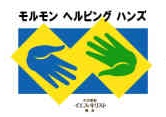 Starting in July 2011, the Church sponsored 'Helping Hands Volunteer Tours,' contracting with a travel agency to run bus tours from Tōkyō to affected areas in Tōhoku. The Church reported that over 500,000 volunteer hours were donated through various Church-sponsored efforts and programs trhough August 2012. Bus fares, lodging, and some meals were paid for by the Church. Volunteer church members, and, if accompanied by a member, investigators or non-member friends from Japan and overseas could participate in these tours. The Church reached out to its members and to RMs to make them aware of the opportunity to volunteer (I was contacted to inform all Sendai RMs through the all-jidai site that existed then). Volunteers could sign up via a webpage that included number of open spots. In my observation, the number of volunteers seemed to far exceed expectations, causing more weeks and more seats to be opened up. A volunteer coordination center was set up at Sendai's Kamisugi building.
Starting in July 2011, the Church sponsored 'Helping Hands Volunteer Tours,' contracting with a travel agency to run bus tours from Tōkyō to affected areas in Tōhoku. The Church reported that over 500,000 volunteer hours were donated through various Church-sponsored efforts and programs trhough August 2012. Bus fares, lodging, and some meals were paid for by the Church. Volunteer church members, and, if accompanied by a member, investigators or non-member friends from Japan and overseas could participate in these tours. The Church reached out to its members and to RMs to make them aware of the opportunity to volunteer (I was contacted to inform all Sendai RMs through the all-jidai site that existed then). Volunteers could sign up via a webpage that included number of open spots. In my observation, the number of volunteers seemed to far exceed expectations, causing more weeks and more seats to be opened up. A volunteer coordination center was set up at Sendai's Kamisugi building.
Service opportunity descriptions:
Overnight and 3-day tours: Bus departs from in front of the Asia North Office in Tōkyō (Hiroo), late evening, travels overnight to Iwate or Miyagi-ken. Bus arrives at designated affected area early morning. Volunteer service from 8:30AM-3PM, then either return by bus to Tokyo ('overnight tour') or for 'three day weekday tour,' group accomodations at Onsen Inn or Hotel. Day 3 repeat volunteer service, then return to Tokyo via bus. For 'three day weekend tours' depart Tokyo on Friday nights, then after one day of service and overnighting at an onsen, Day 3 (Sunday) bus to Sendai Kamisugi Ward for Church, then return to Tōkyō Sunday evening.
|
Helping Hands 'Labor' Volunteers at Furukawa church, before heading out on for that day's assignment. Brother Asano, who lost his house near Shiogama, coordinated these longer-term volunteers. I got be the van driver for the oh-so-much-younger other volunteers.
|
'Labor Volunteer' opportunities were also available through September 2011, headquartered in Furukawa, for those who could perform 'heavy' labor and could stay for extended periods. An old missionary apartment in Furukawa was utilized.
Many RMs from many jidais participated in the Helping Hands opportunities. Admin Note: I was lucky enough be both a 'labor volunteer' for about a week in September 2011 and volunteered again in June 2012 with a group of 11 Teruya RMs for a mini-reunion weekend bus 3-day tour, which has a separate write-up in the reunion section.
Church News Reports (Status, Assistance, Visits)
Here are Church News reports, listed chronogically, that detail missionary and member status, church humanitarian efforts and church leader visits after the disaster
- March 11, 2011 - Japan Earthquake, Tsunami Update
- March 11, 2011 - Church assesses needs after Japan quake, tsunami
- March 12, 2011 - LDS missionaries in Japan all safe
- March 18, 2011 - Japan earthquake facts
- March 18, 2011 - Missionaries safe: Sisters spend time visiting members, giving service
- March 26, 2011 - Church responds to Japan disaster
- April 2, 2011 - Japan: 4,000 Mormons give 40,000 hours
- April 28, 2011 - Evacuated missionaries return to areas of Japan devastation
- May 21, 2011 - Church aid continues: Vans, school bags to help Japan disaster victims
- June 16, 2011 - Japan Sendai Missionaries offer 'Mormon Helping Hands' in Japan recovery effort
- September 10, 2011 - Missionaries in Japan help restore sacred Shinto shrine
- March 1, 2012 - Apostle visits Saints in the Land of the Rising Sun
- March 18, 2012 - Returning to Tohoku - Elder and Sister Oaks visit Japan one year after disaster
- June 24, 2020 - How to view discouragement during COVID-19 through the lens of faith, Elder Stevenson says
- October 24, 2020-The word I learned after the 2011 tsunami in Japan that has great meaning today
Links to some amazing photos of disaster areas from the Internet:


